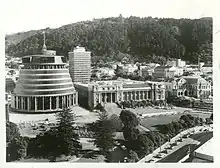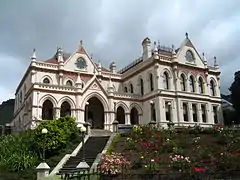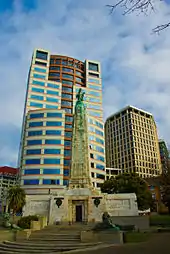New Zealand Parliament Buildings
New Zealand Parliament Buildings (Māori: Ngā whare Paremata[1]) house the New Zealand Parliament and are on a 45,000 square metre site at the northern end of Lambton Quay, Wellington. They consist of the Edwardian neoclassical-style Parliament House (1922); the Parliamentary Library (1899); the executive wing, called "The Beehive" (1977); and Bowen House, in use since 1991. Whilst most of the individual buildings are outstanding for different reasons, the overall setting that has been achieved "has little aesthetic or architectural coherence".[2]


Parliament House
.JPG.webp)
The main building of the complex is Parliament House, containing the debating chamber, speaker's office, visitors' centre, and committee rooms.
Predecessor building burned down
An earlier wooden Parliament House (1870s addition by William Clayton and 1880s by Thomas Turnbull) was destroyed by fire in 1907 along with all other parliament buildings except the library. The library had an iron fire-door that saved its collections.[3] Following the destruction of the building the Parliament occupied the adjacent Government House (the site now occupied by the Beehive) for ten years.[4]
Replacement building
.jpg.webp)
A competition to find a replacement design was announced by Prime Minister Joseph Ward in February 1911 and 33 designs were entered. The winning design, by Government Architect John Campbell, was selected by Colonel Vernon, former Government Architect for New South Wales. As another of Campbell's entries won fourth place, the actual design is a combination of both entries. The design was divided into two stages. The first half, a Neoclassical building, contained both chambers and the second half Bellamy's (the parliamentary cafeteria) and a new Gothic Revival library to replace the existing one.[5][6]
Despite cost concerns, Prime Minister William Massey let construction of the first stage begin in 1914, but without much of the roof ornamentation or the roof domes.[5] The outbreak of World War I created labour and material shortages that made construction difficult. However, members of Parliament (MPs) were so desperate to get out of the run-down old Government House that they moved into the unfinished building in 1918.[4] In 1922, the first stage was completed (the second stage was never built). The building was finally officially opened in 1995 by Queen Elizabeth II, Queen of New Zealand, after its comprehensive strengthening and refurbishment. The intention of the Liberal Government was for the design to be implemented in stages, eventually resulting in a coherent architectural setting. Instead, as Heritage New Zealand remarks, the setting that has been achieved "has little aesthetic or architectural coherence",[7] especially through the construction of the Beehive instead of completion of Parliament House.
The Beehive
.JPG.webp)
The land intended for the second stage of Parliament House is occupied by the Executive Wing. This building conceived by British architect Sir Basil Spence in 1964, largely designed by the Ministry of Works, was officially opened by Elizabeth II, Queen of New Zealand in 1977. The first parliamentary offices moved into the building in 1979.[8] Due to its distinctive shape, it is referred to colloquially as "The Beehive".[8]
The building is ten stories and 72 metres (236 ft) high.[8] The top floor is occupied by the Cabinet room, with the Prime Minister's offices on the floor immediately below. The office of individual ministers, various function rooms, and Bellamy's restaurant occupy the first three floors.
In the late 1990s there was consideration of moving the Beehive behind Parliament House, and finishing Parliament House according to the 1911 original plans. The plan was quickly scuttled due to a lack of public support and concerns about cost.[9]
The Parliamentary Library

Completed in 1899, the Parliamentary Library is the oldest of the buildings. It stands to the north of Parliament House (to its right, looking from the front).
The library was designed in Gothic Revival style and was fire resistant, being constructed of masonry. The third storey of the design was not built to save money. It had an iron fire-door separating the library from the main entrance section. This saved the library from the fire of 1907 which destroyed the rest of the timber parliament buildings.[3]
Along with Parliament House, the library was strengthened and refurbished in the 1990s. This included recreating Gothic elements of the roof including ironwork, turrets, and finials.[10] It still houses Parliament's library.[10] The building is registered with Heritage New Zealand (previously known as the New Zealand Historic Places Trust) as a Category I heritage structure with registration number 217.[11]
Bowen House

A 22-storey office building across Bowen Street from the Beehive, Bowen House houses MPs' offices and support staff and has been leased by Parliamentary Services since 1991.[12] It is connected to the rest of the parliamentary complex by a tunnel under Bowen Street.
Old Government Buildings
Not part of the current parliamentary complex and on the other side of Lambton Quay, this four-storey building was designed by William Clayton and built in 1876. The Old Government Buildings currently house Victoria University of Wellington's Law School as part of Victoria's Pipitea campus. Several rooms featuring displays of the building's history have been set up for public viewing.[13]
References
- "Ngā whare Paremata". teara.govt.nz (in Maori). Te Ara: The Encyclopedia of New Zealand. Retrieved 29 March 2020.
- "Search the List | Parliament House | Heritage New Zealand". www.heritage.org.nz. Retrieved 15 September 2019.
- "Parliamentary library escapes fire". nzhistory.govt.nz. New Zealand History online. 10 December 2018.
- "History of Parliament's buildings and grounds". www.parliament.nz. New Zealand Parliament. Retrieved 9 July 2020.
- "The halfway house – Parliament buildings". New Zealand History Online. Retrieved 12 February 2012.
- "New Parliament Buildings". Thames Star. XLVII (10273). 28 September 1911. p. 1. Retrieved 12 February 2012.
- "Parliament House". Register of Historic Places. Heritage New Zealand. Retrieved 27 July 2015.
- "The Beehive - Executive Wing". New Zealand Parliament. 31 October 2006. Retrieved 21 November 2018.
- "Parliament poised for major building revamp, including plan for new office block". Stuff.co.nz. 12 September 2016. Retrieved 29 March 2020.
- "Parliamentary Library today". www.parliament.nz. New Zealand Parliament. Retrieved 29 March 2020.
- "Parliamentary Library". Register of Historic Places. Heritage New Zealand. Retrieved 10 January 2014.
- Small, Vernon (11 July 2015). "Parliament precinct eyes office revamp". The Press. p. A2. Retrieved 11 July 2015.
- "Government Buildings, Wellington". nzhistory.govt.nz. Ministry for Culture and Heritage. Retrieved 15 June 2019.
External links
| Wikimedia Commons has media related to New Zealand Parliament Buildings. |